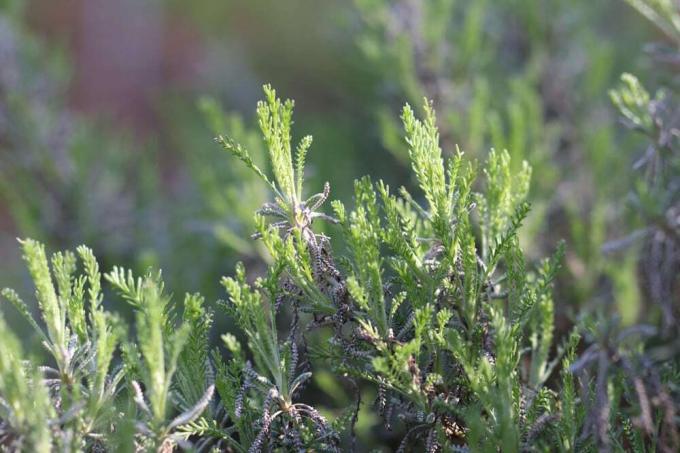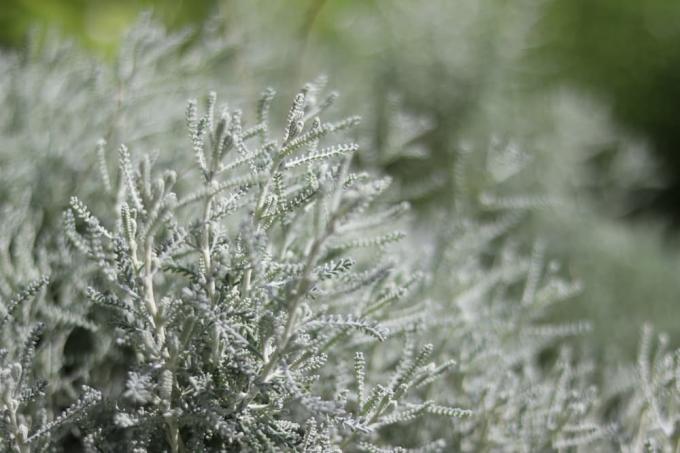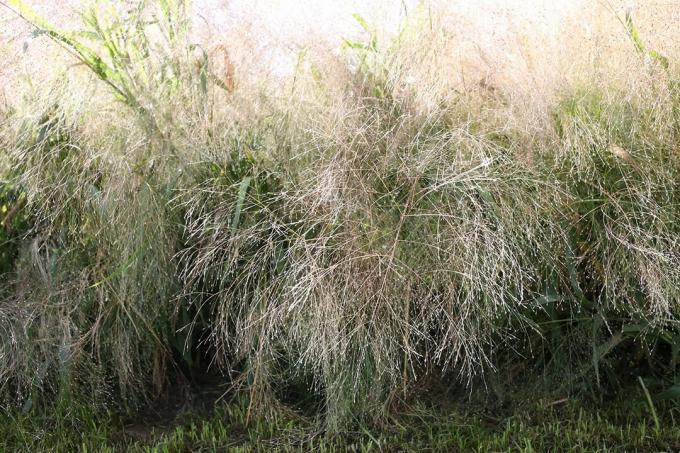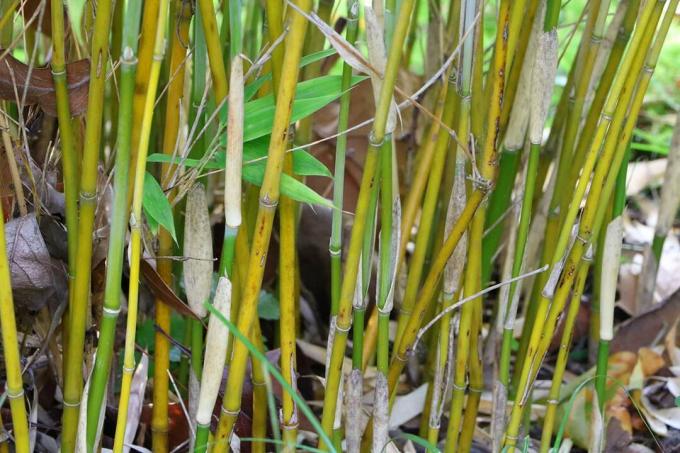

Table of contents
- kind
- companion plants
- Floor
- Fertilize
- Pour
- diseases and pests
- planting
- Cut
- Location
- hibernate
- multiply
- use
There are probably only very few plants that are visually as impressive as the sacred herbs on the one hand, but are also so easy to care for and undemanding on the other. If you follow a few basic rules, you really can't go wrong with a holy herb. Even spending the winter in the garden is possible, although it is actually a Mediterranean plant that loves sun and warmth.
kind
Santolina chamaecyparissus, the botanical name of the holy herb, belongs to the daisy family. It is an evergreen subshrub that can reach a height of up to sixty centimeters. The flowers are small, spherical and yellow. Santolina chamaecyparissus originally comes from the Mediterranean region, where it is still very widespread. It grows there with great preference on stony or rocky ground. This property makes it the ideal companion in Mediterranean gardens or rock gardens. In our latitudes, however, the herb has so far been relatively rare. A total of only three types of saint herb have been cultivated as ornamental plants. It is conditionally hardy and extremely easy to care for.
companion plants
As an ornamental plant, the saint's herb is usually found in a combination of other plants. The combination with roses of all kinds is particularly attractive. In addition, red wild tulips, purple bells or blue bellflowers are perfect as companion plants.
Floor

Sacred herbs do not place high demands on the soil or soil. to the plant substrate. In general, it can be said that the soil should be nutrient-poor and calcareous. It is also important that it is as loose and permeable as possible. Water in particular must be able to drain off extremely well. Santolina likes it dry and cannot cope with waterlogging at all. In case of doubt, it therefore helps to enrich the garden soil with a lot of sand. If the soil at the chosen location contains a lot of clay, drainage made of stones or other materials must be installed in any case. However, it is even better to look for another location for the sacred herb.
Fertilize
As already mentioned several times, the holy herb is an absolutely undemanding plant. The natural nutrients it finds in the soil are perfectly adequate for it to grow and thrive. It is therefore not necessary to fertilize them. On the contrary: Fertilizers can trigger adverse effects and even lead to the death of the plant.
Pour
The holy herb not only loves it warm, but also dry. It therefore does not have to be watered, which of course makes caring for the plant a lot easier. Outdoors, occasional downpours or morning dew are sufficient to provide the plant with sufficient liquid. Santolina chamaecyparissus even survives a long dry period relatively easily. Persistent wetness Rainy periods, on the other hand, can cause considerable problems for the plant.
diseases and pests
Holy herbs are extremely robust and resilient. If they are protected from moisture, they are usually not threatened by diseases. If it is too wet for the plants, there is a risk of root rot in most cases. This can only be combated by drying out quickly. Pests also make a wide berth around this herb. This is due to the essential oils that each shrub produces. The insects are literally repelled by the smell. Incidentally, this also applies to snails that avoid proximity to sacred herbs. The shrub works wonders in this regard near a bed.
planting
As a rule, sacred herbs will be purchased as small shrubs in specialist garden shops. To plant, simply dig a small hollow at the chosen location, into which the root ball easily fits. The cavity is then well filled and poured with plenty of water. Since several shrubs are usually planted at the same time, a sufficiently large distance between the individual plants must be maintained. A minimum distance of around 30 centimeters is recommended. By the way, you can plant practically all year round – unless the ground is frozen or there is an acute threat of a frost period.
Cut
The holy herb not only requires very little care, but is also extremely tough. Therefore, it also tolerates very strong pruning. Although it is not absolutely necessary to cut the shrub, experience has shown that it grows bushier and gains significantly more volume through a cut. In addition, it is possible to shape Santolina with a targeted cut. When cutting, all shoots are well shortened. The timing is important: the cut should be made immediately after flowering and in no case later. Annual pruning is recommended. Sharp knives or pruning shears are suitable tools.
Location
Santolina comes from the sunny south. No wonder, then, that the plant generally prefers a warm location that is as sunny as possible. The plant has no problem with the blazing midday sun. It also copes very well with wind. The location does not have to be particularly protected. For example, planting in a roof garden is possible without having to worry about the plant.
hibernate

It cannot be said often enough: the holy herb is a Mediterranean plant that likes it extremely dry and sunny. It is all the more astonishing that the plant in our latitudes can also cope well with the winter. However, one should be aware that it is only conditionally hardy. Although it can remain outdoors during the winter months, it must then be given special protection. Brushwood in the root area is, so to speak, mandatory. A warm fleece is also recommended. Protection from precipitation, especially snow, is also required. Covering with a garden tarpaulin can be helpful here.
Tip:
Anyone who has cultivated several sacred herbs in one location should think about building a kind of mobile greenhouse for the winter months.
multiply
The propagation of the holy herb is very easy and actually always succeeds. Propagation is done by cuttings. The ideal time for this is early summer. How to proceed:
- Cut off shoot tips that are 15 to 20 centimeters long
- remove the leaves from the lower area
- Put the tips in sandy potting soil and water well
- keep constantly moist until the tips have grown
- Waterlogging must be avoided at all costs
The right location for the cuttings has a lot of light or is at most partially shaded. The young sacred herbs can then be planted in their final location next spring. The best way to overwinter the young plants is in a cool, frost-free and bright basement room. It is now also possible to buy seeds in specialist shops. Propagation can therefore also be done by sowing. This should then also be done in late spring or early summer.
Tip:
When sowing, it is important to follow the manufacturer's recommendations. These can usually be found on the seed packaging.
use
Santolina chamaecyparissus is a typical ornamental plant whose greatest use in the garden is its appearance. Their fresh leaves are basically also suitable for seasoning. Hobby cooks can use it to give meat, fish and pasta dishes a certain flair. Another positive property of hollyhock is that the essential oils it releases repel mosquitoes. It is therefore advisable to always plant the plant where people are - for example, in the immediate vicinity of a terrace. In general, Santolina enhances rock gardens, Mediterranean gardens and, last but not least, roof gardens. It can also be easily cultivated as a container plant.
 garden editorial
garden editorial I write about everything that interests me in my garden.
Learn more about ornamental grasses

cutting bamboo | When and how to cut back bamboo?
Be it as a hedge, solitaire or ground cover, bamboo can be seen more and more often in home gardens. Because the sweet grass is easy to care for and easy to grow. However, the latter can quickly become a problem if the plants are not pruned regularly.

11 Tips for Cutting Grasses | Tools & Co.
Cutting ornamental grass works best with our tips: From choosing the right tool to right time - we have the most useful tips and tricks for you for the annual grass cut summarized.

Switchgrass, Panicum virgatum: Care from A – Z
Switchgrass is an upright-growing, clump-forming grass with narrow leaves. The species is considered to be easy to care for and makes few demands on location and soil. Read how to optimally plant and care for Panicum virgatum.

Zebra grass, Miscanthus sinensis 'Strictus': care from A - Z
In botanical jargon, zebra grass is also called Miscanthus sinensis 'Strictus'. The plants can be used wonderfully as privacy screens and are decorative. From care in the tub to overwintering: You can find information on care from A - Z here.

Grow pampas grass from seeds: we explain how
Pampas grass is considered easy to cultivate and can be successfully propagated by breeding. Under controlled conditions in the planter, the germination success is higher than with direct outdoor sowing. The procedures regarding substrate, choice of location and care hardly differ in these variants.

Grasses as a privacy screen: 20 tall grasses
Numerous grasses are ideal as privacy screens! We present the 20 most popular grasses in this article!



